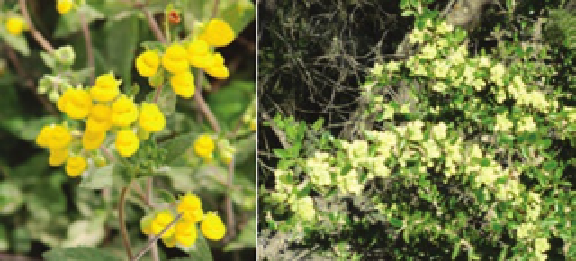Biology Reference
In-Depth Information
(a)
(b)
Fig. 15.1.
Flowers and leaves of (a)
Calceolaria talcana
and (b)
Condalia microphylla.
(Halse
et al.
, 1993; Delgado
et al.
, 2011).
Several
Condalia
species (i.e.
Condalia
buxifolia
) contain cyclopeptide alkaloids
showing several biological activities (Morel
et al.
, 2002). The bark and root of
C. micro-
phylla
have tannins used as dyes for the col-
oration of handcrafts (Gimenez
et al.
, 2008).
Together, the information provided
above reveals that
C. microphylla
produces
several bioactive metabolites. Based on this
and the high resistance of the wood and
leaves to insect and pathogen attack, further
studies have been carried out to determine
insecticidal and insect growth regulatory
effects of the methanol,
n
-hexane, ethyl
acetate and aqueous extracts of aerial parts
(Céspedes
et al.
, 2013).
and Curator Herbarium of University
of Illinois at Urbana-Champaign). Samples
of aerial parts were dried, milled and
then macerated, and concentrated under
vacuum.
Samples of aerial parts (leaves, heart-
wood and bark) of
Condalia microphylla
Cav. were collected during spring 2010
(November) on the slopes of the Andes
Mountains near Los Andes City in Chile
(collection 1) and at the Ecological Reserve
on Campus of Catholic University of
Cordoba, Cordoba, Argentina (collection 2).
Voucher specimens were deposited in the
Herbarium of Basic Science Department,
University of Bio-Bio, Chillán, Chile
(Voucher CLC/0035) and Herbarium
'Dr. Marcelino Sagayo' (Faculty of Agricultural
Sciences, Catholic University of Cordoba,
Argentina). Specimens were identified by
Prof. Gustavo Ruiz, PhD, Director of the
Herbarium. The samples of
C. microphylla
were dried and milled, then were macerated
with methanol and concentrated under
vacuum rotatory evaporation until a viscous
consistency.
15.4
Materials and Methods
15.4.1
Plant materials
Calceolaria talcana
Grau & C. Ehrhart was
collected 4.7 km NW of Confluencia, on
the north shore of the Itata river (36° 37'
21” S, 72° 28' 16” W elevation 170 ft)
Ñuble province, VIII region, Chile, in
November 2010. Voucher specimens have
been deposited in the Herbarium of the
Basic Science Department, University of
Bío-Bío (Voucher DS-2010/05-16243/44)
and in the Herbarium of the University of
Illinois, at Urbana-Champaign, USA, (ILL,
Voucher DS-16243/44). The samples were
identified by Prof. David S. Seigler, PhD
(Full Professor Plant Biology Department
15.4.2
Extracts and fractions
The plants were dried at room temperature,
crushed and then immersed overnight in
methanol. The next day the methanol was
filtered, and the extraction process was
repeated three times. The filtrate was con-
centrated at reduced pressure in a rotary
evaporator at 40°C and 200 mb.

Search WWH ::

Custom Search